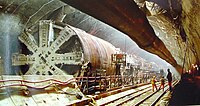
Photo from wikipedia
As the key component of the tunnel boring machine (TBM), the main bearing supports the cutter head as it rotates and breaks rock. It is commonly operated in low-speed, heavy-load,… Click to show full abstract
As the key component of the tunnel boring machine (TBM), the main bearing supports the cutter head as it rotates and breaks rock. It is commonly operated in low-speed, heavy-load, and high-impact circumstances for a long time. Currently, existing vibration monitoring schemes of TBM main bearings cannot effectively detect the fault source due to the sensor installed remotely from the vibration source. Moreover, existing diagnosis methods often involve conventional bearings and cannot be directly applied to TBM main bearings. In this study, we present a two-stream convolutional neural network with multichannel detrending inputs (TSCNN-MCDI) of vibration signals. The model can examine if there is any fault on rollers or entire raceways by analyzing the three-axis vibration signals of the accelerometer inside the roller. The proposed method first removes the motion trend item generated by roller rotation from radial vibration signals by variational mode decomposition. After that, the dual-channel DCNN is used to train the radial vibration data of the roller, while the axial data are trained separately, and then, the fully connected layer fusion is performed, which improves the antinoise performance of the model. The fault datasets of the roller state under different rotational speed conditions are gathered by the TBM main bearing testbed to validate the effectiveness of the proposed method. The antinoise experiment results demonstrate that the accuracy of TSCNN-MCDI reaches 95.52% at low speed when the SNR value is −10 dB, which is much higher than existing algorithms.
Journal Title: IEEE Transactions on Instrumentation and Measurement
Year Published: 2022
Link to full text (if available)
Share on Social Media: Sign Up to like & get
recommendations!